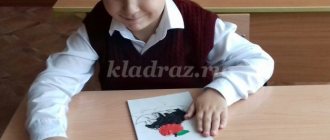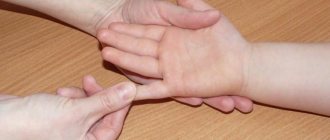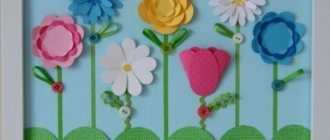Topic: Non-traditional methods for developing fine motor skills in preschool children
Innovative pedagogical experience of the teacher of the structural unit "Kindergarten No. 10 of a combined type" MBDOU "Kindergarten "Rainbow" of a combined type"
Diveeva Irina Alexandrovna .
.
Topic: Non-traditional methods for developing fine motor skills in preschool children.
With the introduction of the Federal State Educational Standard (FSES), education in preschool educational institutions is considered not as a preliminary stage before schooling, but as an independent important period in the life of a child, as an important milestone on the path of continuous education in a person’s life. The problem of developing fine motor skills in children of primary preschool age is reflected in the “Federal State Standard of Preschool Education”. Presented in the target guidelines at the stage of completion of preschool education “The child has developed fine motor skills.” The problem of developing manual skills and fine motor skills is also important for the personal development of the child himself. By owning a hand, a child in the process of his development becomes more independent, autonomous and independent from an adult, which contributes to the development of his initiative in various types of activities. New educational programs for preschool educational institutions are aimed, first of all, at the comprehensive development of the child based on special, specific types of activities inherent in preschoolers. That is, in practice, we received a more playful and versatile approach, welcoming the maximum use of innovative and active methods of pedagogical interaction, more individualized and aimed at unlocking each child’s own potential. Dictating pedagogy has finally been completely eliminated and will be replaced by more modern pedagogy. Fine (fine) motor skills of the hands are the ability to perform precise coordinated actions with the fingers and hands. Fine motor skills are not only necessary in everyday life, they have a great impact on the child’s learning process. That is why, when diagnosing readiness for school, much attention is paid to how well the fine motor skills of preschoolers are developed. In everyday life, every minute we have to perform fine motor skills: fasten buttons, tie shoelaces, hold cutlery. Fine motor skills are important when learning to write and draw: a person’s handwriting will, in particular, depend on the degree of development of these skills. It is in preschool age that special attention should be paid to the development of fine motor skills: by the time the child goes to school, his motor skills must be developed at a sufficient level, otherwise learning at school will be difficult for him. Working with preschool children, I am faced with such problems of children as poor development of the hands, poor memory of colors, shapes, impaired hand motor skills; in such children, slowness in performing movements predominates, and stiffness is observed. When completing tasks, the child begins to be capricious and his mood deteriorates. Understanding the importance of this problem, I set a goal for myself: to develop fine motor skills and hand coordination in preschool children through various activities, through didactic games and toys. The group has created the necessary subject-development environment, acquired games and aids for the development of fine motor skills. Relevance and prospects of experience.
Consultation “Non-traditional techniques for developing fine motor skills in preschool educational institutions”
Irina Antonova
Consultation “Non-traditional techniques for developing fine motor skills in preschool educational institutions”
Non-traditional techniques for developing fine motor skills in preschool educational institutions.
The importance of developing fine motor skills is not discussed ; these skills are necessary for a person not only in childhood, but throughout life. Modern children quickly get bored with the same type of activities. Their life is varied, they want something new and unusual. Every year, children's thirst for knowledge and interest in the world around them increases. There are non-traditional techniques for developing fine motor skills that children will be delighted with and definitely won’t get bored with.
Non-traditional methods of visual activity develop children's motor skills and creative abilities. Such classes are important especially for children with speech impairments.
Relevance of the topic.
Visual activities in preschool educational institutions are one of the natural activities for children. While leading it, many opportunities arise for solving a wide range of problems of an educational and educational nature.
Work in this area in preschool educational institutions pursues the goal motor coordination of the fingers and the hand in general in children 5 teach children to draw objects and natural phenomena using non-traditional drawing techniques .
The perfection of motor coordination of the hands and fingers allows the child to master writing. The level of development of motor skills , the level of preschoolers’ mastery of non-traditional drawing techniques (drawing with a wooden stick, using a foam rubber swab, potato stamps, drawing with woolen threads, as well as with fingers) determine the level of success of a child’s education in primary school, the readiness of the hand to letter.
In recent years, in preschool educational institutions, in the process of preparing children for writing, attention has been focused on preparing the hand for writing. This is due to the fact that cases have become more frequent when a child is already in first grade, and his hand is either insufficiently prepared or not at all prepared for writing. Therefore, he finds it very difficult to cope with the daily amount of writing in class.
There are several related problems here:
• The child has poorly developed fine motor coordination of the hands and fine motor skills ;
• Poorly developed ability to navigate on a plane;
• Weak level of speech activity;
• The child does not perform tasks according to the model well enough; he has poor development of hand-eye coordination .
In view of these problems, the method of developing fine motor skills using non-traditional drawing methods is relevant. She prepares the preschooler's hand for writing.
Drawing using non-traditional techniques does not tire children ; they perform tasks with high activity and efficiency throughout the entire duration of the lesson.
The use of non-traditional drawing techniques contributes to:
• Development in preschoolers of motor coordination of hands and fingers, eye, visual perception, orientation on a sheet of paper;
• Development of skills and abilities that help prepare the child’s hand for writing;
• Development of imagination and perception, and therefore cognitive abilities;
• Emotionally positive attitude towards drawing;
• Self-expression of personality, i.e. display of one’s own fantasy and emotional world.
Based on the above, this topic is currently very relevant and gives the teacher the opportunity for creativity.
Types of non-traditional techniques for developing fine motor skills .
Drawing with fingers
You can use either gouache or special finger paints. The child dips his fingers in paint and draws with them on a piece of paper. To implement this technique, you can use not only a regular album, but also a sheet of whatman paper or a piece of wallpaper. And you can draw while sitting on the floor. Children usually really like this type of drawing; you can even draw using this method on an old white sheet, then wash it, dry it, and draw on it again.
Palm drawing
This type of drawing is similar to the previous method, only the child will draw not with his fingers, but with his entire palm at once. If you dip your fingers in different paints, you will get a rainbow pattern.
Drawing with dots
The preschooler dips his finger in the paint, then places it on the sheet perpendicularly, and so on several times until a drawing is formed.
Drawing with imprints of objects
for this technique : a bottle cap and a small plate.
Blotography
This method causes great delight among children. Using a spoon, paint is poured onto the paper, and then you take a tube and you need to blow through it onto the paint without touching it. After this, you can place a sheet of paper on the resulting drawing and compare the original and the print. You can dream up what the blot looks like.
Drawing with a stencil
This method of visual activity has been known even to adults since childhood.
Spray
The technique consists of the child taking paint on a brush and spraying it in random order. You can use different colors.
Leaf prints
While walking with the children, the teacher needs to collect leaves from the bushes and trees located in the garden. During the lesson, children decorate leaves with paint and transfer prints to a sheet of paper. You can create a whole composition from different leaves.
Foam rubber drawing
Various shapes are cut out of foam rubber, they are fixed on a stick (for example, on a wire or pencil)
. These pieces are dipped in paint and printed on paper.
Chalk drawing
An elementary form of creativity, harmless, safe, even safer than drawing with felt-tip pens. with crayons on a special board indoors or outdoors.
Drawing on wet paper
This method helps if your child needs to draw something with vague outlines, such as fog. The background for the drawing can be made not with an ordinary brush, but with cotton wool or foam rubber.
The list of non-traditional types of drawing can be continued. The most important thing is a flight of imagination; you cannot limit yourself to ordinary drawing with pencils or a brush.
Non-traditional techniques also include paintings painted with pieces of fabric . Various scraps of fabric are collected in a separate bag or box, then these pieces are cut into small pieces and glued to paper.
You can draw a picture with crumpled paper - crumple the paper sheet with your hands, dip it in paint and make an imprint on the sheet.
Children are always interested in unconventional techniques ; they are interested in everything unusual and new. Also, during classes at a preschool educational institution, you can make crafts from non-traditional materials , for example, use items that are no longer needed and give them a second life. You can draw on fabric, for example, let your child draw a design on a T-shirt himself.
It is important to carry out daily procedures that require the child to concentrate on working with his fingers. Thus, the development of fine motor skills will have a positive effect not only on the preschooler’s speech, but also on the coordination of movements.
Methods of teaching non-traditional drawing techniques .
• Creating a game situation and interesting moments.
• Talking through the stages of work.
• Demonstration by the teacher, the use of a multimedia presentation with images on the stages of correct hand position in the process of learning new techniques .
• Finger exercises, special exercises for training hands and fingers, massages that promote the development of fine motor skills .
• Examination of illustrations from books and paintings.
• Accompaniment with musical works.
• Design of exhibitions.
• Independent activity of children.
Expected Result
• Creation of prerequisites for educational activities (generalized methods of action, self-control)
and children's ability to interact with each other.
• Development of fine motor skills of preschoolers' hands.
• Increasing the level of development of creative skills.
• Enrichment and expansion of artistic experience. The ability for preschoolers to actively assimilate artistic experience.
• Independence in the process of choosing a theme, plot, artistic materials, composition and instruments.
The effectiveness of assimilation of the program should be monitored at the beginning of work with the group and at the end through diagnostics. The results must be entered into a summary table. The level of mastery of the program can be assessed by comparing initial and final results.
Integration of educational areas
1. “Reading fiction”: reading, learning and discussing works of fiction in the process of preliminary work.
2. “Communication”: the development of communication skills is carried out during the communication of children with the teacher, expanding the vocabulary of children.
3. “Artistic creativity”: preschoolers participate in the creation of collective and individual drawings, plot compositions; they use different materials and methods of creating images. is developing .
4. “Cognition”: sensory development , children’s horizons expand.
5. “Socialization”: preschoolers become familiar with generally accepted norms of interaction with adults and peers, they learn to objectively evaluate their own capabilities and develop the ability to overcome difficulties.
6. “Safety”: compliance with the simplest safety rules when working with different materials.
7. “Music”: by listening to audio recordings, preschoolers become familiar with the sounds of nature and music.
8. “Labor”: fostering a value-based and respectful attitude towards one’s own work and the work of the people around us.
9. “Health”: when performing work, correct posture is formed, the desire to take care of one’s health, performing physical exercises and warm-ups.
Guidelines
When organizing a lesson in non-traditional drawing, it is important to remember that in order for preschoolers to effectively master skills and abilities, the individual and age characteristics of children, their interests and desires should be taken into account. As the child grows, the content of the lessons expands, the elements become more complex, the shape of the paper changes, and new means of expression arise.
Bibliography
1. Davydova G. N. Non-traditional drawing technique in kindergarten. Part 2. – M.: “Publishing house Scriptorium 2003”
, 2008. – 72 p.
2. Kazakova R. G., Sayganova T. I. Drawing with preschool children: Non-traditional techniques , planning, lesson notes . – M.: Sfera, 2005. – 155 p.
3. Nikitina A.V. Non-traditional drawing techniques in kindergarten – St. Petersburg: “KARO” 2007.
4. Nikitina A.V. Non-traditional drawing techniques in kindergarten: planning, lesson notes : a guide for educators and interested parents. – St. Petersburg: KARO, 2008. – 90 p.
5. Nemeshaeva E. Finger painting. First drawing lessons. For the little ones - M.: Astrel LLC, 2012. - 80 p.
6. Pishchikova N. G. Working with paper in non-traditional techniques - M : LLC “Scriptorium 2003” 2006.
7. Fateeva A. A. Drawing without a brush. - Yaroslavl: Academy of Development : Academy Holding, 2004.





